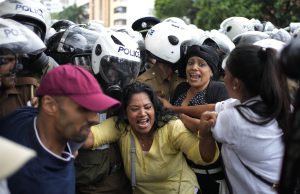On November 2, Sri Lankan opposition parties called for a rally against the Ranil Wickremesinghe administration. It was a failure. At several points in the protest rally, it appeared that there were more security forces than there were protesters.
This was a far cry from the massive demonstrations that toppled the Gotabaya Rajapaksa administration some months ago. The failure of the rally seems to have buoyed some politicians of the Sri Lanka Podujana Peramuna (SLPP).
So why was there a low turnout at the recent protests? And what does this mean for the Wickremesinghe administration? Is it secure in power? While the protests were a dud, the road ahead for the Wickremesinghe administration is likely to be tough.
What Were the Protests About?
A large number of anti-government activists who led the anti-Gotabaya Rajapaksa protests earlier this year are under arrest. Some have been detained on charges under the draconian Prevention of Terrorism Act (PTA). There are fears that the lives of some of the activists are in danger. Lobbying efforts and scattered protests demanding their release have failed and this is the main reason why protests on November 2 were organized.
The protests were led by a coalition of opposition parties including the Samagi Jana Balawegaya (SJB), Sri Lanka Freedom Party (SLFP), the Frontline Socialist Party (FSP), and some trade unions. One of the notable absentees was the Janatha Vimukthi Peramuna (JVP). The Uttara Sabagaya, comprising a group of left-leaning SLPP MPs, was not invited to the protests.
The absence of the JVP was the main reason for the low turnout. The JVP, Sri Lanka’s largest left-wing political party, is riding a wave of popularity among Sri Lankans. It also has the backing of a large group of the strongest and most militant trade unions and boasts a dedicated cadre. Even at its lowest ebb, the JVP possessed the ability to mobilize a larger number of people to its rallies than political parties like the SLPP, SJB, or the SLFP, which do not have dedicated cadres or formal organizational structures needed to maintain continuous public mobilizations.
In the days leading to the protests, the JVP distanced itself from the demonstrations, describing their organizers as regressive.
The JVP also has an axe to grind with the FSP, which is a breakaway group from the JVP. The split, which occurred in 2011, severely weakened the JVP as it lost the powerful student unions that were once its main source of power. The JVP has never forgiven the FSP for that. In recent months, it has ignored calls by left-leaning activists to patch up with the FSP and agree on a minimum common platform to face government suppression.
The JVP has been strongly criticizing the FSP — many of its activists are in prison — for working with centrist political parties like the SJB, which it describes as “regressive forces.” The JVP’s campaign too played a role in many people not joining the protests.
Following the failure of the rally, rifts have opened between FSP and other political parties that took part in the protests.
The JVP has a history of not joining protests and union action organized by other political parties. In the 1980s, it boycotted a general strike called by Sri Lanka’s leftist parties and trade unions. Then-President J. R. Jayawardena cracked down on the strike. The failure of the strike discredited the leftist parties and in its aftermath, the JVP emerged as the leading leftist party in Sri Lanka.
The Ranil Factor
After two years of Gotabaya Rajapaksa’s antics, President Ranil Wickremesinghe represents to Sri Lankans a return to familiarity. A nephew of Jayawardena, Wickremesinghe has been in politics for over four decades and, with the Central Bank Governor Dr. Nandalal Weerasinghe, has managed to stabilize the economy. Tourists are coming in slowly, with the country making a billion dollars in the first 10 months of the year. The fuel and gas queues have disappeared. Power cuts have reduced and despite the shrinking of the economy and the job losses, the situation has dramatically improved since the departure of Gotabaya. Therefore, a large section of Sri Lankans is willing to give Wickremesinghe a chance.
However, Wickremesinghe is aware that this is a reprieve. Sri Lanka can manage to get along as long as it does not have to finance debt. However, to make the investments needed to get the economy back on track, Sri Lanka needs to restructure its debt, get the IMF facility, and secure bridging finance. Progress has been slow on all these fronts. While tourism has indeed picked up compared to last year, the government has reduced the expected tourist arrivals for 2022 to 800,000 from one million. According to M. Shanthikumar, the head of The Hotels Association of Sri Lanka (THASL) the industry does not expect a large influx of tourism in November and December, some of the peak months for tourism.
The Wickremesinghe administration has also failed to make the political reforms that it promised. A few months ago, parliament was entrusted with the tasks of setting up a National Council; appointing the Banking and Financial Services Committee, the Economic Stabilization Committee and the Committee on Ways and Means related to banking affairs; selecting five youth representatives for the Sectoral committees; and establishing the Parliamentary Budget Office. Only the National Council has been established so far. While his backers from the SLPP might not know it, Wickremesinghe is aware that political reforms are necessary for the stability and legitimacy of his government.
Last week, he sent a letter to the Speaker stating that “Parliament has not made satisfactory progress in making far-reaching systematic changes that the country needs.”
Given that he can dissolve Parliament in a few months, this can also be seen as a veiled threat to his own parliamentarians. At a minimum, the president seems to be aware that the public will not tolerate continuous economic difficulties and that the government needs to come up with tangible solutions to problems.

































